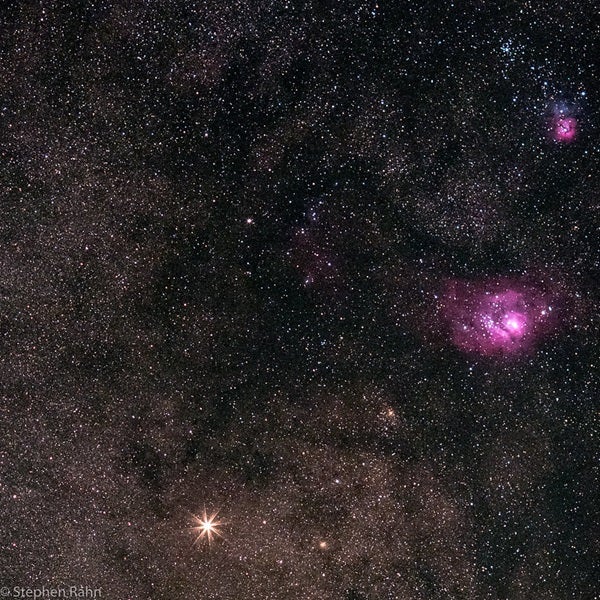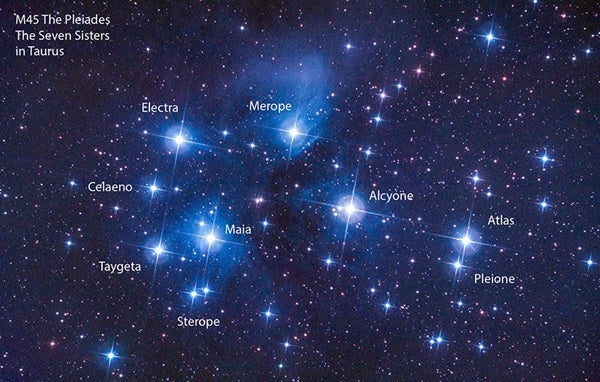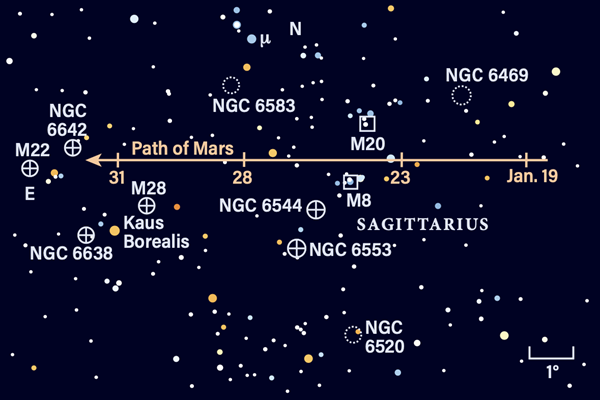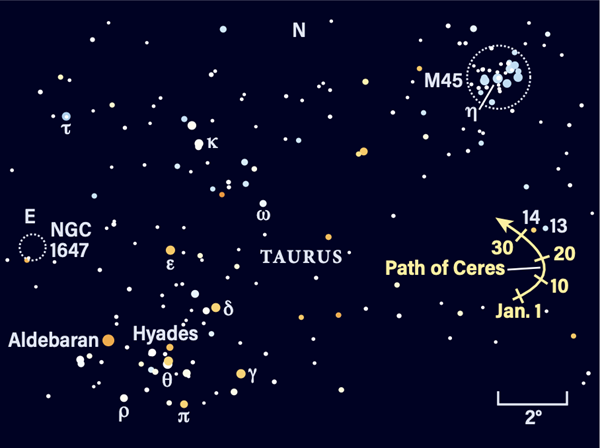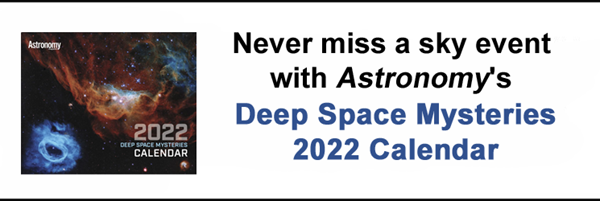Friday, January 21
As the sky grows dark after sunset this evening, look west to catch a glimpse of the large constellation Pegasus, slowly flying toward the horizon in the coming hours.
The most recognizable portion of this constellation is the asterism called the Great Square of Pegasus, formed by Markab (Alpha [α] Pegasi), Scheat (Beta [β] Pegasi), Algenib (Gamma [γ] Pegasi), and Alpheratz (which actually sits just over the celestial border in Andromeda as its alpha star). Also easily recognizable is Enif (Epsilon [ϵ] Pegasi), which marks the Winged Horse’s nose in the southwestern region of the constellation.
After darkness falls and before the Moon rises, let’s try to find one of Pegasus’ premier targets: Stephan’s Quintet. Discovered by French astronomer Édouard Stephan in 1877, these five galaxies form a compact group that, even with a mid-size (6-inch) scope, will likely appear as a lumpy, fuzzy glow some 3′ wide. You’ll really want to bump up the magnification and aperture here if you can. A 12-inch scope will resolve that glow into individual galaxies.
If you’re up for the challenge find the Quintet by first going to the Great Square and locating Scheat in its northwestern corner. From there, skim 5° west-northwest to 3rd-magnitude Matar (Eta [η] Pegasi). Stephan’s Quintet is just 4° north-northwest of this star. Try to search it out early, as soon as it gets dark. This region of sky will set later in the evening but even before then, it will sink into the turbulent air near the ground, making these targets even more difficult to see.
Sunrise: 7:17 A.M.
Sunset: 5:06 P.M.
Moonrise: 8:56 P.M.
Moonset: 9:40 A.M.
Moon Phase: Waning gibbous (86%)
*Times for sunrise, sunset, moonrise, and moonset are given in local time from 40° N 90° W. The Moon’s illumination is given at 12 P.M. local time from the same location.
Saturday, January 22
Many skygazers, regardless of experience, can find the constellation Orion by his bright belt of three stars. But can you find the hare at the hunter’s feet?
The constellation Lepus sits directly below (south) of Orion. It is also due west of bright Sirius, which blazes in Canis Major. Lepus’ two brightest stars are Arneb (Alpha Leporis) at magnitude 2.6 and Nihal (Beta Leporis) at magnitude 2.9. Arneb sits 3° north of Nihal, and both are located south of the midway point on a line drawn between Orion’s bright knees, Rigel and Saiph.
As the sky gets darker still, you’ll find one Messier object in Lepus: M79, a magnitude 7.7 globular cluster. This compact group of stars covers a little less than 10′ and actually sits in a region of the sky where such clusters are rare — opposite the galactic center. Anyone looking toward the edge of the galaxy from within or near the center of the Milky Way would measure M79 as 60,000 light-years away. From our vantage point farther out, we measure M79 at 40,000 light-years from Earth.
Sunrise: 7:17 A.M.
Sunset: 5:07 P.M.
Moonrise: 10:01 P.M.
Moonset: 10:05 A.M.
Moon Phase: Waning gibbous (77%)
Sunday, January 23
Mercury reaches inferior conjunction at 5 A.M. EST. It’s now hidden from our view by the Sun’s bright glare but will just begin to peek out of the dawn as a morning object by the end of the month.
Instead, let’s focus tonight on a fascinating object that’s easy to view: the Pleaides (M45). This large open cluster spans 110′ on the sky and is already 66° high an hour after sunset. Look south to find this young cluster of stars about 14° northwest of Aldebaran in Taurus the Bull. Many people think the Pleiades looks like a spoon or ladle, and some even confuse it with the Little Dipper (which is much larger, fainter, and in the north). At least six bright stars are visible to the naked eye, including 5th-magnitude Pleione, a known variable. Pleione is a rapidly spinning star whose motion causes changes in its brightness and even the type of spectrum astronomers observe from it. By carefully comparing Pleione’s brightness to its neighboring stars over the course of a few observations, you, too, may be able to tell that it’s changing with time!
The American Association of Variable Star Observers has more on this star and how to observe it as part of their Monthly Featured Variables webpage.
Sunrise: 7:16 A.M.
Sunset: 5:09 P.M.
Moonrise: 11:07 P.M.
Moonset: 10:29 A.M.
Moon Phase: Waning gibbous (69%)
Monday, January 24
Saturn and Jupiter are sinking fast in the evening sky, but netting the planet Neptune is a slightly less-harried affair. The distant planet is still 30° high an hour after sunset, floating above bright Jupiter and just at the border between Capricornus and Pisces.
First, while it’s still up, find Jupiter — that’s easy, since the giant planet is a bright magnitude –2.1. Enjoy a telescopic view of its alternating light and dark belts while you can, as the planet will continue sinking lower at sunset each day for the rest of the month, blurring out its detail.
Once it’s dark enough, two 4th-magnitude stars will appear to Jupiter’s upper left (northeast): Hydor 6.2° northeast of Jupiter and Phi (ϕ) Aquarii another 5.5° northeast of Hydor. (Hydor is brighter than Phi.) Another 3.7° northeast of Phi is Neptune, whose magnitude 7.8 glow you’ll pick up with binoculars or any small scope. You’ll notice it lies close (18′) to a 6th-magnitude field star — Neptune is the fainter, “flatter” star and might appear gray or blue to your eyes. Its disk currently spans just 2″ — but that’s because the massive planet is some 2.9 billion miles (4.7 billion kilometers) from Earth.
Sunrise: 7:15 A.M.
Sunset: 5:10 P.M.
Moonrise: —
Moonset: 10:54 A.M.
Moon Phase: Waning gibbous (59%)
Tuesday, January 25
Last Quarter Moon occurs at 8:41 A.M. EST, rising just after midnight on the 24th and standing highest at dawn. But you don’t need to be a pre-dawn riser to enjoy this phase, which is visible in the bright daytime sky until just before noon.
It is true that early-morning, pre-dawn observations will net you some stunning views, though. Now is the time to enjoy the long line of craters marching down the middle of our Moon, as well as the long, sweeping curve of the Apennine Mountains, which form the southeastern rim of Mare Imbrium (the Sea of Rains). Imbrium also shows off two large, prominent craters in the waning sunlight: Plato at its top and Archimedes toward its bottom.
Readily visible is the bright, rayed crater Copernicus, which lies southwest of Imbrium. And marching downward, just west of the terminator dividing light from day, are large craters that include (among many more) Ptolemaeus, Alphonsus, and Arzachel.
Sunrise: 7:14 A.M.
Sunset: 5:11 P.M.
Moonrise: 12:15 A.M.
Moonset: 11:21 A.M.
Moon Phase: Waning crescent (48%)
Wednesday, January 26
Through the end of January, 1st-magnitude Mars is skimming through a particularly rich Milky Way region of Sagittarius. Check out the chart above — you won’t want to miss a single meetup!
By this morning, the Red Planet is less than a Moon’s width from the northeastern edge of the breathtaking Lagoon Nebula (M8) — a stunning sight you can enjoy through binoculars or any telescope. The Lagoon is a bright (6th magnitude) star-forming region stretching some 90′ by 40′. Although the Lagoon will appear as a soft gray glow to your eyes, photographs will bring out its deep red color, which results from its abundant hydrogen gas.
Just 1° to the planet’s northwest is the equally beautiful Trifid Nebula (M20). It’s much dimmer — magnitude 9 — and smaller as well, covering 28′ (a little less than the width of the Full Moon). The Trifid is a combination emission and reflection nebula, with dark dust lanes running through it that give it its unique name. According to Astronomy columnist Phil Harrington, you’ll want binoculars with at least 50x to see those dark lanes. Although it is small and not as stunning visually, the Trifid shows up spectacularly in images — so astrophotographers, you’ll definitely want to capture this scene.
Sunrise: 7:14 A.M.
Sunset: 5:12 P.M.
Moonrise: 1:27 A.M.
Moonset: 11:52 A.M.
Moon Phase: Waning crescent (37%)
Thursday January 27
Comet 19P/Borrelly is still some 47° high an hour after sunset tonight. With no Moon to interfere, see if you can track down this periodic visitor, which today sits near the irregular dwarf galaxy IC 1613 in Cetus the Whale.
The nearest bright stellar signpost to guide your way is magnitude 3.8 Alrescha (Alpha Piscium). From there, scan 11.5° west-southwest to land right on Borrelly’s soft, 9th- to 10th-magnutude glow. You’ll ideally want a 4-inch scope or larger, and more aperture may net you a bit more detail in the round, fuzzball-like coma, revealing its well-defined northern flank.
IC 1613, also classified as Caldwell 51, is just less than 3° northwest of Borrelly tonight. It, too, glows a soft magnitude 10, and may appear as two slightly brighter smudges with a darker region between them. This small, relatively dust-free galaxy is a member of our Local Group and is located just 2 million light-years away.
Sunrise: 7:13 A.M.
Sunset: 5:13 P.M.
Moonrise: 2:41 A.M.
Moonset: 12:30 P.M.
Moon Phase: Waning crescent (26%)
Friday, January 28
Today, asteroid 44 Nysa begins a five-day journey across the open star cluster NGC 1647 in Taurus the Bull. The constellation currently rises before sunset and is climbing higher in the eastern sky by the time darkness falls.
The easiest way to find the 6th-magnitude, 45′-wide cluster is to first find bright red Aldebaran, the Bull’s eye. Notice the smattering of stars nearby — that’s the Hyades, another young open cluster. Flip the Hyades over to the northeast side of Aldebaran, and you’ll be smack dab in NGC 1647’s domain. Nysa is currently 10th magnitude and visible with good binoculars or a small scope. It sits on the NGC 1647’s southwestern edge tonight and may be a bit difficult to discern from some of the cluster’s stars at first glance. But give it some time — within three hours or so, you’ll be able to pick up Nysa’s movement against the background.
Over the next several nights, the main-belt world will traverse the cluster, moving northeast. Check back night after night to see how much progress it’s made. Plus, if you want an additional target, use our chart to skim west and find 8th-magnitude dwarf planet 1 Ceres, less than 5° south of the sparkling Pleiades star cluster.
Sunrise: 7:12 A.M.
Sunset: 5:15 P.M.
Moonrise: 3:56 A.M.
Moonset: 1:17 P.M.
Moon Phase: Waning crescent (17%)

